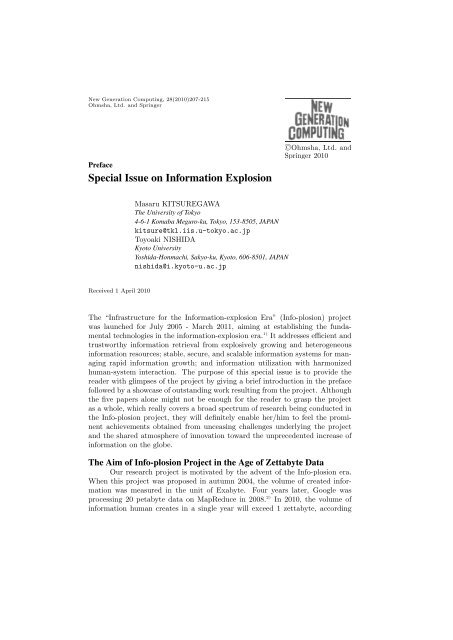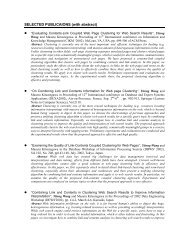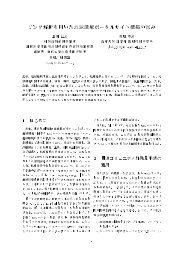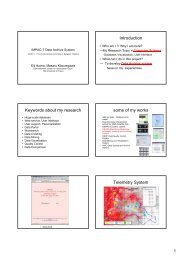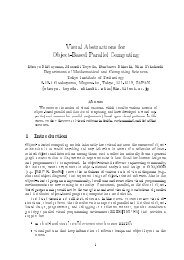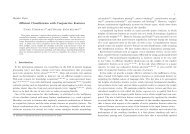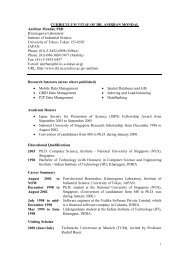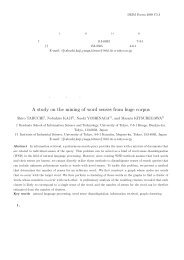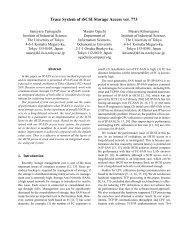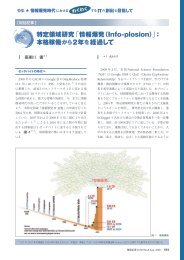Special Issue on Information Explosion
Special Issue on Information Explosion
Special Issue on Information Explosion
Create successful ePaper yourself
Turn your PDF publications into a flip-book with our unique Google optimized e-Paper software.
New Generati<strong>on</strong> Computing, 28(2010)207-215<br />
Ohmsha, Ltd. and Springer<br />
Preface<br />
<str<strong>on</strong>g>Special</str<strong>on</strong>g> <str<strong>on</strong>g>Issue</str<strong>on</strong>g> <strong>on</strong> Informati<strong>on</strong> Explosi<strong>on</strong><br />
Received 1 April 2010<br />
Masaru KITSUREGAWA<br />
The University of Tokyo<br />
4-6-1 Komaba Meguro-ku, Tokyo, 153-8505, JAPAN<br />
kitsure@tkl.iis.u-tokyo.ac.jp<br />
Toyoaki NISHIDA<br />
Kyoto University<br />
Yoshida-H<strong>on</strong>machi, Sakyo-ku, Kyoto, 606-8501, JAPAN<br />
nishida@i.kyoto-u.ac.jp<br />
The “Infrastructure for the Informati<strong>on</strong>-explosi<strong>on</strong> Era” (Info-plosi<strong>on</strong>) project<br />
was launched for July 2005 - March 2011, aiming at establishing the fundamental<br />
technologies in the informati<strong>on</strong>-explosi<strong>on</strong> era. 1) It addresses efficient and<br />
trustworthy informati<strong>on</strong> retrieval from explosively growing and heterogeneous<br />
informati<strong>on</strong> resources; stable, secure, and scalable informati<strong>on</strong> systems for managing<br />
rapid informati<strong>on</strong> growth; and informati<strong>on</strong> utilizati<strong>on</strong> with harm<strong>on</strong>ized<br />
human-system interacti<strong>on</strong>. The purpose of this special issue is to provide the<br />
reader with glimpses of the project by giving a brief introducti<strong>on</strong> in the preface<br />
followed by a showcase of outstanding work resulting from the project. Although<br />
the five papers al<strong>on</strong>e might not be enough for the reader to grasp the project<br />
as a whole, which really covers a broad spectrum of research being c<strong>on</strong>ducted in<br />
the Info-plosi<strong>on</strong> project, they will definitely enable her/him to feel the prominent<br />
achievements obtained from unceasing challenges underlying the project<br />
and the shared atmosphere of innovati<strong>on</strong> toward the unprecedented increase of<br />
informati<strong>on</strong> <strong>on</strong> the globe.<br />
The Aim of Info-plosi<strong>on</strong> Project in the Age of Zettabyte Data<br />
Our research project is motivated by the advent of the Info-plosi<strong>on</strong> era.<br />
When this project was proposed in autumn 2004, the volume of created informati<strong>on</strong><br />
was measured in the unit of Exabyte. Four years later, Google was<br />
processing 20 petabyte data <strong>on</strong> MapReduce in 2008. 2) In 2010, the volume of<br />
informati<strong>on</strong> human creates in a single year will exceed 1 zettabyte, according
ngc28300 : 2010/7/14(10:21)<br />
208 M. Kitsuregawa and T. Nishida<br />
Fig. 1 Informati<strong>on</strong> Explosi<strong>on</strong>, or “Info-plosi<strong>on</strong>” 4)<br />
to IDC 3) (Fig. 1). We are in the midst of Informati<strong>on</strong> explosi<strong>on</strong> (Info-plosi<strong>on</strong>).<br />
What our project aims at is, in short, focusing <strong>on</strong> Info-plosi<strong>on</strong> as a phenomen<strong>on</strong><br />
and taking it as a new challenge for researchers in the informati<strong>on</strong> field: 1) We<br />
identify various problems that arise in the Info-plosi<strong>on</strong> era, and tackle them with<br />
pi<strong>on</strong>eer work. 2) Instead of regarding Info-plosi<strong>on</strong> as headaches, we challenge<br />
unprecedented research works in a positive attitude to create values from the<br />
explosive informati<strong>on</strong>. Generally speaking, research projects in this field usually<br />
aim at a clearly defined specific target. This project, <strong>on</strong> the other hand, has<br />
wider focus <strong>on</strong> the phenomen<strong>on</strong> of Info-plosi<strong>on</strong> as a whole. Thinking it over,<br />
it is researchers in the informati<strong>on</strong> field who gave the bases of this Info-plosi<strong>on</strong><br />
phenomen<strong>on</strong>. We are resp<strong>on</strong>sible to overcome this phenomen<strong>on</strong>.<br />
Web Search-engine Infrastructure Based <strong>on</strong> NLP In the Info-plosi<strong>on</strong> era, <strong>on</strong>e<br />
of the most serious problems is overloading of informati<strong>on</strong>. Because the volume<br />
of flooding informati<strong>on</strong> exceeds the ability of acceptance of individuals, the<br />
relative distance to reach necessary informati<strong>on</strong> becomes l<strong>on</strong>ger rather than it<br />
previously was. Therefore, a method to find exact informati<strong>on</strong> has become much<br />
more important. Although searching informati<strong>on</strong> sounds a classical topic, the<br />
situati<strong>on</strong> has been dramatically changed in the Info-plosi<strong>on</strong> era. One of the<br />
Info-plosi<strong>on</strong> we have to tackle is textual informati<strong>on</strong> <strong>on</strong> the Web. The existing<br />
search engines functi<strong>on</strong> well for a so-called navigati<strong>on</strong>al search, locating the top<br />
pages of companies, shops, and restaurants. However, they cannot support an<br />
informati<strong>on</strong>al search in a satisfactory way, such as “problems in child-rearing” in<br />
general, “a decline in the children’s physical strength,” or “measures against chil-
<str<strong>on</strong>g>Special</str<strong>on</strong>g> <str<strong>on</strong>g>Issue</str<strong>on</strong>g> <strong>on</strong> Informati<strong>on</strong> Explosi<strong>on</strong> 209<br />
Fig. 2 An Open Search-engine Infrastructure: TSUBAKI 5)<br />
dren’s physical strength decline.” We need much more powerful, next-generati<strong>on</strong><br />
search facilities to exploit the accumulated informati<strong>on</strong> <strong>on</strong> the Web. Our Infoplosi<strong>on</strong><br />
Project puts stress <strong>on</strong> research infrastructures, and has c<strong>on</strong>structed an<br />
open search-engine infrastructure, called TSUBAKI developed by Kurohashi and<br />
Shinzato (Kyoto University), for next-generati<strong>on</strong> search technologies based <strong>on</strong><br />
deep natural language processing (NLP). 5) TSUBAKI is equipped with 100 milli<strong>on</strong><br />
Japanese Web pages, cleaned up and marked up with sentence boundaries<br />
for each page, and preprocessed with the morphological analyses, syntactic analyses<br />
and syn<strong>on</strong>ymous expressi<strong>on</strong> analyses for sentences. The resultant enriched<br />
data is stored in an XML-based format. In additi<strong>on</strong> to words, syn<strong>on</strong>ymous expressi<strong>on</strong>s<br />
and dependency relati<strong>on</strong>s are registered in the index, which enables<br />
TSUBAKI to handle complex natural language expressi<strong>on</strong>s in queries and documents<br />
and to identify syn<strong>on</strong>ymous expressi<strong>on</strong>s (Fig. 2).<br />
TSUBAKI is not <strong>on</strong>ly used through ordinary Web browsers, but it also<br />
provides an open access to its Web corpus and search APIs. A large text corpus<br />
is essential to knowledge extracti<strong>on</strong> and enhancement of NLP, and the XMLbased<br />
100-milli<strong>on</strong>-page corpus has been widely used in the research community.<br />
Furthermore, white-boxed TSUBAKI APIs are supporting the next-generati<strong>on</strong><br />
search research activities, such as clustering-based Web informati<strong>on</strong> summarizati<strong>on</strong>,<br />
or opini<strong>on</strong> and sentiment overview.
210 M. Kitsuregawa and T. Nishida<br />
Innovative Search Technologies As Web is expected to be a huge library which<br />
collects human knowledge, users expect more c<strong>on</strong>venience of search. This requires<br />
thorough localizati<strong>on</strong> for each language, as TSUBAKI has realized, which<br />
is c<strong>on</strong>sidered to be a weak point of existing commercial search engines developed<br />
in the United States. As advanced search technologies, in additi<strong>on</strong> to<br />
search under complex c<strong>on</strong>diti<strong>on</strong>s, another difficult problem to solve <strong>on</strong> the Web<br />
is to grasp different opini<strong>on</strong>s. Generally, there is a wide variety of opini<strong>on</strong>s for<br />
social problems. Examples of such problems include: “baby post (an<strong>on</strong>ymous<br />
commissi<strong>on</strong> system of baby whom parents cannot raise),” “medical care for elderly<br />
people,” and “hospital managed by an incorporated company.” However,<br />
because current commercial search engines display major opini<strong>on</strong>s by ranking<br />
methods, it is difficult to find minor opini<strong>on</strong>s. Even the existence of such minor<br />
opini<strong>on</strong>s might be overlooked, despite their fresh points of view of the problem.<br />
A system called “Opini<strong>on</strong>Reader” developed by Fujii (University of Tsukuba)<br />
focuses <strong>on</strong> this point. Also, it is impossible to know what we d<strong>on</strong>’t know <strong>on</strong> the<br />
Web. In order to help finding this “unknown unknown,” Torisawa (NICT) et al.<br />
have developed “TORISHIKI-KAI” in this project. 9) They have c<strong>on</strong>structed a<br />
milli<strong>on</strong>-word-scale semantic network which can be browsed as a Web search directory.<br />
This has a functi<strong>on</strong> such as showing hidden problems and generalizati<strong>on</strong><br />
of topics, which is useful for finding “unknown unknowns.”<br />
Development of Research Platforms to Support Info-plosi<strong>on</strong> Experiments For<br />
challenging such a deep analysis of complex queries and comprehensi<strong>on</strong> of l<strong>on</strong>gtailed<br />
informati<strong>on</strong>, it is not enough to put an original processing system <strong>on</strong><br />
top of current commercial search engines, because they <strong>on</strong>ly display top 1000<br />
pages which may not include l<strong>on</strong>g-tailed informati<strong>on</strong>. That is to say, we must<br />
crawl and parse a huge volume of Web pages by ourselves in order to achieve<br />
such fundamental research works. Since it is extremely troublesome for individual<br />
researchers to manage such things all by themselves, we have provided<br />
co-developed research platforms in our project. Such a strategy is becoming<br />
more important for computer science. One of the platforms is a large-scale distributed<br />
computing envir<strong>on</strong>ment called “InTrigger” ∗1 developed by Taura (University<br />
of Tokyo) et al., which collects more than 1000 CPU cores. Recently,<br />
middleware suitable for a large-scale cluster were developed such as MapReduce,<br />
Hadoop, and PigLatin. They have features to process a huge volume of<br />
data, although the amount of calculati<strong>on</strong> for each data is relatively small. This is<br />
completely different from c<strong>on</strong>venti<strong>on</strong>al scientific calculati<strong>on</strong> performed <strong>on</strong> a supercomputer.<br />
Development of such a computing envir<strong>on</strong>ment is interesting for<br />
system researchers, while this is also an exciting platform for researchers who<br />
want to process a huge volume of data in them. Various research systems including<br />
“TSUBAKI” have been developed using InTrigger. Other co-developed<br />
research platforms include “IMADE” developed by Sumi, B<strong>on</strong>o, and Nishida<br />
(Kyoto University). 6) This is a sensor room equipped with latest devices which<br />
∗1 http://www.intrigger.jp/
<str<strong>on</strong>g>Special</str<strong>on</strong>g> <str<strong>on</strong>g>Issue</str<strong>on</strong>g> <strong>on</strong> Informati<strong>on</strong> Explosi<strong>on</strong> 211<br />
Fig. 3 Preventive Healthcare with Vital Sensor Network 8)<br />
trace sensitive interacti<strong>on</strong> am<strong>on</strong>g multiple people. “SlothLib” is a toolkit for<br />
making own search applicati<strong>on</strong>s developed by Oshima, Nakamura, and Tanaka<br />
(Kyoto University). 7) Web applicati<strong>on</strong>s can be built up up<strong>on</strong> SlothLib instantly<br />
without elaborate programming, realized by using commercial search engines.<br />
Creati<strong>on</strong> of Value Extracting Informati<strong>on</strong> from Info-plosi<strong>on</strong> While we are in the<br />
age of Info-plosi<strong>on</strong>, the situati<strong>on</strong> was completely different 25 years ago – we were<br />
in hunger for informati<strong>on</strong> in those days. Since an explosive volume of data is<br />
available today, we should make use of the data aggressively. The increase of the<br />
volume of data is largely due to the progress of sensor technologies. There are a<br />
number of innovative projects using sensors such as analyzing soil c<strong>on</strong>diti<strong>on</strong>s for<br />
cultivati<strong>on</strong>, improving efficiency of logistics, PLM for safety of products, and so<br />
<strong>on</strong>. They seem to possess business scenarios to create new values by extracting<br />
precious informati<strong>on</strong> from Info-plosi<strong>on</strong>. They have great possibilities in the<br />
coming Info-plosi<strong>on</strong> era. Our project focuses <strong>on</strong> sensors for human activities,<br />
and makes researches into preventive healthcare with a vital sensor network<br />
developed by Inoue (Kyushu Institute of Technology) and Nakashima (Kyushu<br />
University) (Fig. 3). 8)<br />
Informati<strong>on</strong> Can be Medicine The Ministry of Health, Labour and Welfare of<br />
Japan reported that the number of diabetics increased to 8.2 milli<strong>on</strong>. On the<br />
other hand, the number of diabetic specialists is <strong>on</strong>ly less than 4 thousand, which<br />
means <strong>on</strong>e specialist must treat over two thousand patients. This leads to the<br />
nati<strong>on</strong>al increase of medical cost by causing atherosclerotic diseases or by causing<br />
renal diseases. Accordingly, our goals are to prevent and c<strong>on</strong>trol diabetes mellitus,<br />
using a sensor network to capture vital informati<strong>on</strong> and record lifestyles of<br />
patients. ∗2 Sensor networks will optimize disease management, since observati<strong>on</strong><br />
∗2 The issues are discussed in disease management in more general.
212 M. Kitsuregawa and T. Nishida<br />
must be made in the daily life of patients out of hospitals. We c<strong>on</strong>ducted two<br />
verificati<strong>on</strong> studies: <strong>on</strong>e for metabolic syndrome, which was shown as the main<br />
cause of diabetes in recent studies as obesity with visceral fat accumulati<strong>on</strong>, and<br />
another for diabetes.<br />
The first study aimed at managing metabolic syndromes. We asked <strong>on</strong>e<br />
hundred m<strong>on</strong>itors to wear activity sensors and pulse rate sensors, and to use<br />
wireless weight scales and blood pressure sensors for 11 days. On the 6th day,<br />
health instructors suggested lifestyle problems, up<strong>on</strong> the sensor data, to the m<strong>on</strong>itors.<br />
The sensed data were automatically uploaded to the server via Bluetooth<br />
or wireless LAN. The result showed that 91.6 % of the m<strong>on</strong>itors increased their<br />
amount of exercise (9.55 % increase in average (n = 83)) after the healthcare<br />
instructi<strong>on</strong>. In the analysis of the kinds of activities, “standing” and “walking”<br />
were increased, and “using elevator” was apparently decreased in daily behaviors.<br />
Additi<strong>on</strong>ally, we could estimate the optimizati<strong>on</strong> of health instructi<strong>on</strong>s<br />
in both time and accuracy, which should lead to enormous cost reducti<strong>on</strong> of<br />
Particular Health Checkup System held all over Japan.<br />
The sec<strong>on</strong>d study targeted <strong>on</strong> diabetics. We used activity sensors, blood<br />
sugar sensors, weight scales, and blood pressure sensors. The former two were<br />
mobile, and all the data were uploaded via mobile ph<strong>on</strong>es or wireless LAN. The<br />
mobile ph<strong>on</strong>e had an applicati<strong>on</strong> to show the recommendati<strong>on</strong> message either<br />
triggered by the sensor data or sent daily. As the result, we found a critical<br />
case of reverse white coat hypertensi<strong>on</strong>, where the blood pressure is high <strong>on</strong>ly at<br />
out of hospital. Moreover, according to the analysis of recommendati<strong>on</strong> effect,<br />
the frequency of measuring vital informati<strong>on</strong> increased after a recommendati<strong>on</strong>,<br />
and several messages certainly increased the amount of activities, and several<br />
decreased. These results have not been found in our studies so far without<br />
such an envir<strong>on</strong>ment. In additi<strong>on</strong>, we developed a collecting system of activity<br />
informati<strong>on</strong> using smart ph<strong>on</strong>es, and gathered well-labeled 3D accelerometer<br />
data of 150 people. Since smart ph<strong>on</strong>es have been deployed tens of milli<strong>on</strong>s in<br />
the world, they can be a global platform for progress of activity recogniti<strong>on</strong>.<br />
Papers in This <str<strong>on</strong>g>Special</str<strong>on</strong>g> <str<strong>on</strong>g>Issue</str<strong>on</strong>g><br />
This special issue c<strong>on</strong>tains five papers. The first paper 9) addresses automated<br />
c<strong>on</strong>structi<strong>on</strong> of a semantic network by making use of the huge informati<strong>on</strong><br />
resource of the Web. The challenge of this work is to go bey<strong>on</strong>d the c<strong>on</strong>venti<strong>on</strong>al<br />
keyword-based Web search, to enable the user to find informati<strong>on</strong> that <strong>on</strong>e might<br />
not even know. The main c<strong>on</strong>tributi<strong>on</strong> of this work is the development of the<br />
collective body of knowledge acquisiti<strong>on</strong> methods for automatically generating<br />
TORISHIKI-KAI, a machinery that maps out the c<strong>on</strong>text of use or handling of<br />
the topic the user inputs, and classifies topically related search terms according<br />
to semantic categories.<br />
The sec<strong>on</strong>d paper 10) presents a model-based approach to fault localizati<strong>on</strong><br />
that allows the human analyst to narrow down the fault localizati<strong>on</strong> in largescale<br />
computing envir<strong>on</strong>ments. Localizati<strong>on</strong> is regarded as anomaly detecti<strong>on</strong><br />
problems in system behaviors by automatically analyzing data resulting from
<str<strong>on</strong>g>Special</str<strong>on</strong>g> <str<strong>on</strong>g>Issue</str<strong>on</strong>g> <strong>on</strong> Informati<strong>on</strong> Explosi<strong>on</strong> 213<br />
recording all the functi<strong>on</strong> call traces and identifies anomalous behaviors. The key<br />
challenge here is the development of a scalable, automated technique of detecting<br />
anomalies that can effectively localize faults in large-scale envir<strong>on</strong>ments. Their<br />
c<strong>on</strong>tributi<strong>on</strong> is twofold. The pre-failure model derivati<strong>on</strong> permits to build an<br />
executi<strong>on</strong> model that reflects the functi<strong>on</strong>-calling behaviors of the target system,<br />
based <strong>on</strong> functi<strong>on</strong>-call traces collected from all processes. The post-failure modelbased<br />
anomaly detecti<strong>on</strong> allows for identifying the most deviant behaviors in the<br />
failed run by comparing the failure traces with the derived model.<br />
The third paper 11) addresses a high performance shared file system for<br />
a large-scale PC cluster system to share data and support distributed dataintensive<br />
computing. Key issues include maximizing the distributed file I/O<br />
bandwidth, avoiding access c<strong>on</strong>centrati<strong>on</strong>, and supporting fault tolerance. The<br />
c<strong>on</strong>tributi<strong>on</strong> of this paper is a global distributed file system called Gfarm Grid<br />
that federates local file systems <strong>on</strong> compute nodes and allows multiple file replicas<br />
in any locati<strong>on</strong>. Gfarm Grid features data-locati<strong>on</strong>-aware process scheduling that<br />
allows the user to manage file partiti<strong>on</strong>ing and file replica placement for better<br />
file I/O performance.<br />
The fourth paper 12) addresses image annotati<strong>on</strong> and retrieval. The problem<br />
is challenging because of various appearances of objects and a wide variety<br />
of categories. The key idea introduced in this paper is to combine the higherorder<br />
local auto-correlati<strong>on</strong> features and a framework of probabilistic can<strong>on</strong>ical<br />
correlati<strong>on</strong> analysis. The highly compressed nature of the intrinsic space arising<br />
from c<strong>on</strong>ceptual learning between images and labels allows for faster and more<br />
accurate image annotati<strong>on</strong> and retrieval results.<br />
The last paper 13) aims at building a speech processing technology that is<br />
robust against the intrinsic variati<strong>on</strong>s, differences of speaker, microph<strong>on</strong>e, envir<strong>on</strong>ment,<br />
etc. They derive speech structures as completely transform-invariant<br />
features and discuss their linguistic and psychological validity. The idea is applied<br />
to automatic speech recogniti<strong>on</strong> and computer-aided language learning.<br />
C<strong>on</strong>cluding Remarks<br />
Wikipedia defines informati<strong>on</strong> explosi<strong>on</strong> as follow: “The informati<strong>on</strong> explosi<strong>on</strong><br />
is the rapid increase in the amount of published informati<strong>on</strong> and the<br />
effects of this abundance of data. As the amount of available data grows, the<br />
problem of managing the informati<strong>on</strong> becomes more difficult, which can lead to<br />
informati<strong>on</strong> overload.” Wikipedia and others address its negative aspect such as<br />
management difficulty of informati<strong>on</strong> and informati<strong>on</strong> overload. On the other<br />
hand, we can c<strong>on</strong>sider this phenomen<strong>on</strong> a yet another opportunity for this century.<br />
Thirty years ago, there were no web, no emails. Students were waiting<br />
for new issue of academic journals. Airfare was so expensive and a quite small<br />
number of professors could attend internati<strong>on</strong>al c<strong>on</strong>ferences whose number was<br />
also very few. In those days, people starved for informati<strong>on</strong>. Now informati<strong>on</strong><br />
is explosively increasing and its overload becomes a serious problem. In other<br />
words, this is the first experience for human beings to face such overwhelming<br />
informati<strong>on</strong>.
214 M. Kitsuregawa and T. Nishida<br />
In Info-plosi<strong>on</strong> project, we are challenging two aspects of informati<strong>on</strong><br />
explosi<strong>on</strong>. First, in order to overcome the negative aspects of informati<strong>on</strong> explosi<strong>on</strong>,<br />
we have been building the system TSUBAKI. The goal is ‘Bey<strong>on</strong>d Search.’<br />
It is much more powerful compared with the current commercial search engines.<br />
We do not pursue its quick resp<strong>on</strong>se time at all which is extremely important<br />
for current advertisement-based commercial search engines; to the c<strong>on</strong>trary, we<br />
are focusing <strong>on</strong> the quality of the results. It can answer far more complicated<br />
queries than the customary keyword-based simple queries. Sec<strong>on</strong>d, we have<br />
been challenging value extracti<strong>on</strong> from explosive informati<strong>on</strong>. Informati<strong>on</strong> was<br />
scarce before, now informati<strong>on</strong> is so abundant. This implies that we are able<br />
to utilize such informati<strong>on</strong> to extract various values, which was very difficult<br />
in old centuries. Google announced they found <strong>on</strong>e trilli<strong>on</strong> pages in 2008. The<br />
amount of surface web informati<strong>on</strong> space, however, is not that large. Nowadays,<br />
people can express their opini<strong>on</strong>s easily in their blog and twitter. This enables<br />
us to sense the world’s emoti<strong>on</strong>. IOT (Internet of things) is expected to generate<br />
far more informati<strong>on</strong>, which potentially sense phenomena happening in<br />
the world much more in depth. In the Info-plosi<strong>on</strong> project, we c<strong>on</strong>ducted various<br />
system development and experiments <strong>on</strong> sensor-based health care soluti<strong>on</strong>.<br />
Using accelerometer, we could measure the activities of each individual patient<br />
quantitatively, which led to pers<strong>on</strong>alized medicati<strong>on</strong>.<br />
When we started the Info-plosi<strong>on</strong> project, the problem caused by informati<strong>on</strong><br />
explosi<strong>on</strong> was addressed. As far as we knew, there were no academic<br />
projects that focused <strong>on</strong> the issue. Thus, we decided to launch it in Japan. The<br />
style of the project is rather unusual. In c<strong>on</strong>trast to the clearly defined targets<br />
of systems development aimed at by other <strong>on</strong>going projects, such as GRID, ITS<br />
or Supercomputer, informati<strong>on</strong> explosi<strong>on</strong> is just a phenomen<strong>on</strong>. We c<strong>on</strong>sidered<br />
that we had to do something with informati<strong>on</strong> explosi<strong>on</strong>, although we did not<br />
know exactly what we had to do. We have called for proposals three times during<br />
these five year project period in order to identify the key issues in the informati<strong>on</strong><br />
explosi<strong>on</strong> era. So far, we have reas<strong>on</strong>ably succeeded in the sense that our<br />
project have derived numerous interesting results. Now we have come to believe<br />
that Info-plosi<strong>on</strong> will be a key enabler for the next generati<strong>on</strong> IT systems.<br />
Acknowledgements<br />
We thank members of the guest editorial board: Hiroshi Nakagawa, Akiko<br />
Aizawa, Satoshi Matsuoka, Shigeru Chiba, Takashi Matsuyama, and Hiroshi G.<br />
Okuno for their support throughout the whole publicati<strong>on</strong> processes, an<strong>on</strong>ymous<br />
reviewers for their high-quality review, Masato Oguchi for his assistance<br />
in writing this preface, and Takashi Chikayama, an associate editor of the New<br />
Generati<strong>on</strong> Computing journal, for kind and useful advices. The research reported<br />
in this special issue is supported by Grant-in-aid for Scientific Research<br />
<strong>on</strong> Priority Areas: “Cyber Infrastructure for the Informati<strong>on</strong> Explosi<strong>on</strong> Era” of<br />
The Ministry of Educati<strong>on</strong>, Culture, Sports, Science and Technology (MEXT),<br />
Japan. We are grateful for the c<strong>on</strong>tinued support.
<str<strong>on</strong>g>Special</str<strong>on</strong>g> <str<strong>on</strong>g>Issue</str<strong>on</strong>g> <strong>on</strong> Informati<strong>on</strong> Explosi<strong>on</strong> 215<br />
References<br />
1) Kitsuregawa, M., “Creating Vital Informati<strong>on</strong> Technologies for the Info-plosi<strong>on</strong><br />
Era: Info-plosi<strong>on</strong> Project: Current Reports (in Japanese),” IPSJ Magazine, 49,<br />
8, pp.881–888, Aug. 2008.<br />
2) Dean, J. and Ghemawat, S., “MapReduce: Simplified Data Processing <strong>on</strong> Large<br />
Clusters,” CACM, 51, 1, Jan. 2008.<br />
3) IDC white paper: “The Diverse and Exploding Digital Universe,” 2008.<br />
http://www.emc.com/collateral/analyst-reports/diverse-exploding-digitaluniverse.pdf<br />
4) Moore, F., “Storage New Game, New Rules,” Horis<strong>on</strong> Informati<strong>on</strong> Strategies,<br />
2003. http://www.horis<strong>on</strong>.com/topics/2004/08/newrules pg34.pdf<br />
5) Shinzato, K., Shibata, T., Kawahara, D., Hashimoto, C. and Kurohashi, S.,<br />
“TSUBAKI: An Open Search Engine Infrastructure for Developing New Informati<strong>on</strong><br />
Access Methodology,” in Proc. of Third Internati<strong>on</strong>al Joint C<strong>on</strong>ference<br />
<strong>on</strong> Natural Language Processing (IJCNLP2008), pp.189–196, Hyderabad, India,<br />
2008.<br />
6) Sumi, Y., Nishida, T., B<strong>on</strong>o, M. and Kijima, H., “IMADE: Research Envir<strong>on</strong>ment<br />
of Real-World Interacti<strong>on</strong>s for Structural Understanding and C<strong>on</strong>tent<br />
Extracti<strong>on</strong> of C<strong>on</strong>versati<strong>on</strong> (in Japanese),” IPSJ Magazine, 49, 8, pp.945–949,<br />
Aug. 2008.<br />
7) Ohshima, H., Nakamura, S. and Tanaka, K., “SlothLib: A programming library<br />
for research <strong>on</strong> web search,” DBSJ letters, 6, 1, pp.113–116, Jun. 2007.<br />
8) Nakashima, N., Inoue, S., Tsuruta, H., Sudo, O., Kobayashi, K., Inoguchi, T.,<br />
“INFO-MEDICINE CONCEPT, Informati<strong>on</strong> can be a Medicine if it is Provided<br />
in a Timely and Appropriate Manner,” in Proc. of the 12nd China-Japan-Korea<br />
Medical Informatics C<strong>on</strong>ference, pp.22–25, 2009.<br />
9) Torisawa, K. et al, “Organizing the Web’s Informati<strong>on</strong> Explosi<strong>on</strong> to Discover<br />
Unknown Unknowns,” New Gener. Comput. (in this issue).<br />
10) Maruyama, N. and Matsuoka, S., “Model-Based Fault Localizati<strong>on</strong>: Finding<br />
Behavioral Outliers in Large-Scale Computing Systems,” New Gener. Comput.<br />
(in this issue).<br />
11) Tatebe, N., Hiraga, K. and Soda, N., “Gfarm Grid File System,” New Gener.<br />
Comput. (in this issue).<br />
12) Harada, T. et al, “Image Annotati<strong>on</strong> and Retrieval for Weakly Labeled Images<br />
using C<strong>on</strong>ceptual Learning,” New Gener. Comput. (in this issue).<br />
13) Minematsu, N., Asakawa, S. and Suzuki, M., “Speech Structure and Its Applicati<strong>on</strong><br />
to Robust Speech Processing,” New Gener. Comput. (in this issue).


